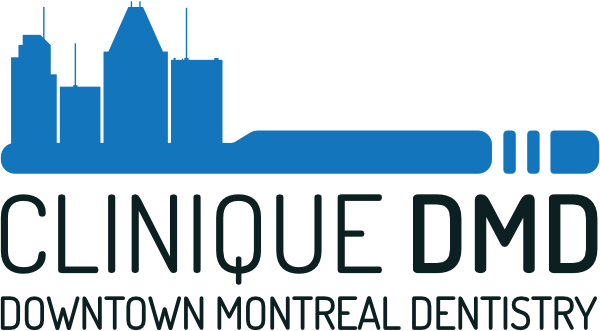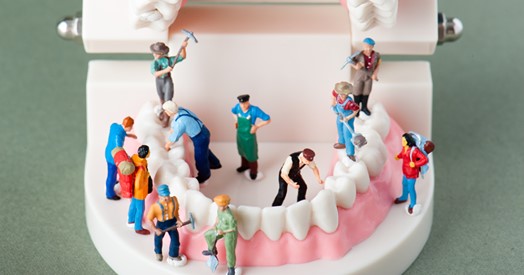Breaking a tooth can be stressful! Whether through an accident, doing something you shouldn’t (like biting you fingernails, for example), or because of a cavity, a broken tooth can really ruin your day. Luckily, in the vast majority of cases, the tooth can likely be repaired.
At Downtown Montreal Dentistry, we see a lot of patients with broken teeth. In fact we have seen them broken in every different way possible. From a small chip to a crack into the nerve, we are able to use modern restorative and cosmetic procedures to repair damaged teeth. The right treatment for you will depend on how badly your tooth is damaged, but there are options so you don’t have to live with an unattractive tooth.
Why people get cracked or broken teeth
The hardest tissue in your body is the enamel that covers your teeth but it can still be broken. Teeth can be damaged in many ways. Some of the more interesting ways we have heard of our patients breaking teeth are:
- Opening bottles
- Tearing open packages
- Removing staples
- Chewing ice
- Getting knocked in the face by a variety of objects (including fists)
- Kissing too vigorously (yes that is a real one)
Chewing food can also cause teeth to break, and not just biting into olive pits or nut shells. Sometimes a seemingly harmless soft food will cause a chip. This can be because the tooth has been accumulating stress over time, until finally it gives way. Tooth decay or cavities can also weaken your teeth, causing them to be more likely to break when you are chewing hard food.
Types of cracked teeth
Several types of cracked teeth exist.
- Craze lines. These are tiny cracks that only affect the outer enamel. Craze lines are common for adults. They are shallow, cause no pain, and are of no concern beyond the way they look.
- Fractured cusp. When a piece of a tooth’s chewing surface breaks off, it’s called a fractured cusp. Sometimes a tooth can be painful to bite on for a while until suddenly a cusp fractures. Often after that, the pain is resolved.
- Cracked tooth. A cracked tooth means a crack extends from the chewing surface vertically toward the root. Early diagnosis is important in this case to save the tooth. Sometimes a shallow crack can be repaired with a simple filling, whereas a deeper one may need a root canal and/or crown. A cracked tooth left untreated will get worse as time goes by and can result in a loss of the tooth. Early treatment is essential in saving cracked teeth.
- Split tooth. A split tooth is usually the result of a long-term cracked tooth. It is identified by a crack with distinct segments that can be separated. A split tooth cannot be saved intact.
- Root fracture. Commonly occur due to a trauma, or in a tooth with an root canal and post but no crown. Often, they show minimal signs and symptoms and are only discovered when the surrounding bone and gum become infected.
Here are five procedures that can repair your cracked or broken tooth. Our dentist will determine which of the following treatments is best for you and your mouth.
1. Dental bonding
Composite bonding can be used to repair broken teeth. This is the while filling material that we dentists use to fix cavities, and repairing a broken tooth is much the same procedure. We roughen up the tooth, treat the surface with different solutions to make it sticky, and then apply on the bonding. It can be shaped and formed to the right shape and then hardened with a blue light. Finally it is polished to shine like real enamel.
2. Veneers
Veneers are porcelain covers for the front of your tooth. They can usually be done with minimal drilling of your tooth, but can have a drastic impact on the shape and colour of the tooth. Repairing a broken tooth with a veneer can be a good conservative option, but it is usually only recommended if the break is not too severe. If the tooth is more severely fractured, we might need to progress to the next option
3. Crowns
If your tooth is chipped badly or has a large cusp fracture, you may need a crown. Crowns are one of the most common restorative treatments.
A crown is a cap that covers the tooth and protects in and approves the appearance. It acts as a strong covering for your tooth. When you get a crown, this prevents you from losing your tooth. Without a crown, a damaged tooth won’t be able to withstand the pressure of chewing.
Crowns can be made of different materials but most commonly are tooth coloured and indistinguishable from natural teeth.
4. Root Canal
If you have a crack in your tooth that has extended into the tooth’s nerve, the tooth may need a root canal. This is done because once the nerve is exposed to your mouth, bacteria can infect it and cause it to become painful or even die. Getting a root canal involves clearing out and removing the nerve. This procedure has a bad reputation for being painful. But if it’s done right, you should feel no pain or only minor discomfort. More often than not, and particularly on a back tooth, a crown is strongly recommended after a root canal. This is to protect the tooth again cracking again.
If you have a toothache, sensitivity, or swelling, you may need a root canal. Left untreated, infection can spread, causing abscess, bone loss, and other serious problems.
5. Dental Implant
A dental implant is obviously not a method to repair a broken tooth, but sometimes when a tooth is not fixable, extraction and replacement becomes the only option. An implant is like an artificial tooth root, on which a tooth crown is placed. It looks and functions like a natural tooth.
A broken tooth should be treated promptly to avoid further problems, pain and expense. If you have a broken tooth, give us a call at 514-844-3112, or visit our website at downtownmontrealdentistry.com


